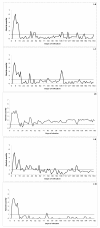Variant -and individual dependent nature of persistent Anaplasma phagocytophilum infection
- PMID: 20398321
- PMCID: PMC2859769
- DOI: 10.1186/1751-0147-52-25
Variant -and individual dependent nature of persistent Anaplasma phagocytophilum infection
Abstract
Background: Anaplasma phagocytophilum is the causative agent of tick-borne fever in ruminants and human granulocytotropic anaplasmosis (HGA). The bacterium is able to survive for several months in immune-competent sheep by modifying important cellular and humoral defence mechanisms. Little is known about how different strains of A. phagocytophilum propagate in their natural hosts during persistent infection.
Methods: Two groups of five lambs were infected with each of two 16S rRNA gene variants of A. phagocytophilum, i.e. 16S variant 1 which is identical to GenBank no M73220 and 16S variant 2 which is identical to GenBank no AF336220, respectively. The lambs were infected intravenously and followed by blood sampling for six months. A. phagocytophilum infection in the peripheral blood was detected by absolute quantitative real-time PCR.
Results: Both 16S rRNA gene variants of A. phagocytophilum established persistent infection for at least six months and showed cyclic bacteraemias, but variant 1 introduced more frequent periods of bacteraemia and higher number of organisms than 16S rRNA gene variant 2 in the peripheral blood.
Conclusion: Organisms were available from blood more or less constantly during the persistent infection and there were individual differences in cyclic activity of A. phagocytophilum in the infected animals. Two 16S rRNA gene variants of A. phagocytophilum show differences in cyclic activity during persistent infection in lambs.
Figures







References
-
- Brodie TA, Holmes PH, Urquhart GM. Some aspects of tick-borne diseases of British sheep. Vet Rec. 1986;118:415–418. - PubMed
Publication types
MeSH terms
Substances
LinkOut - more resources
Full Text Sources

